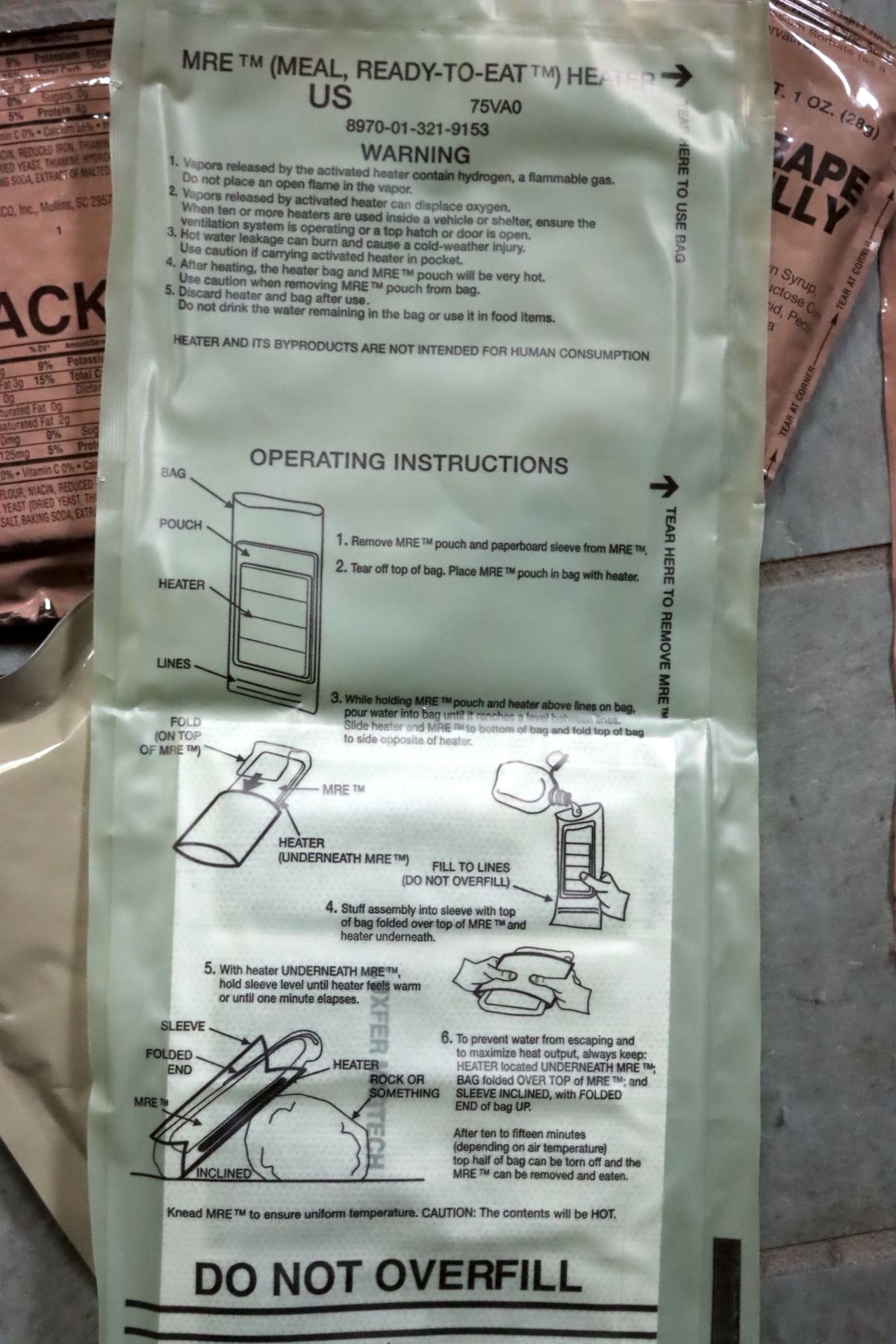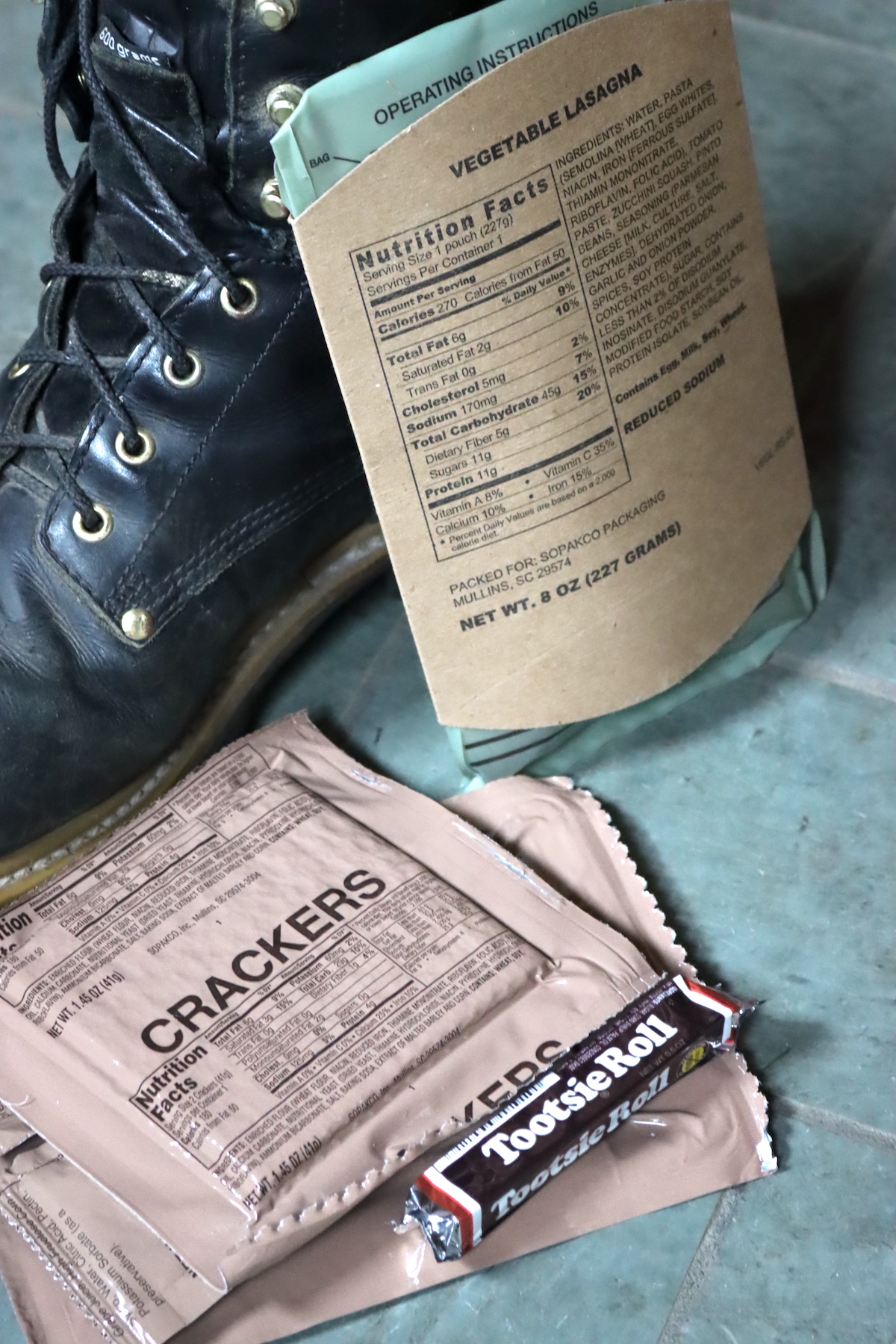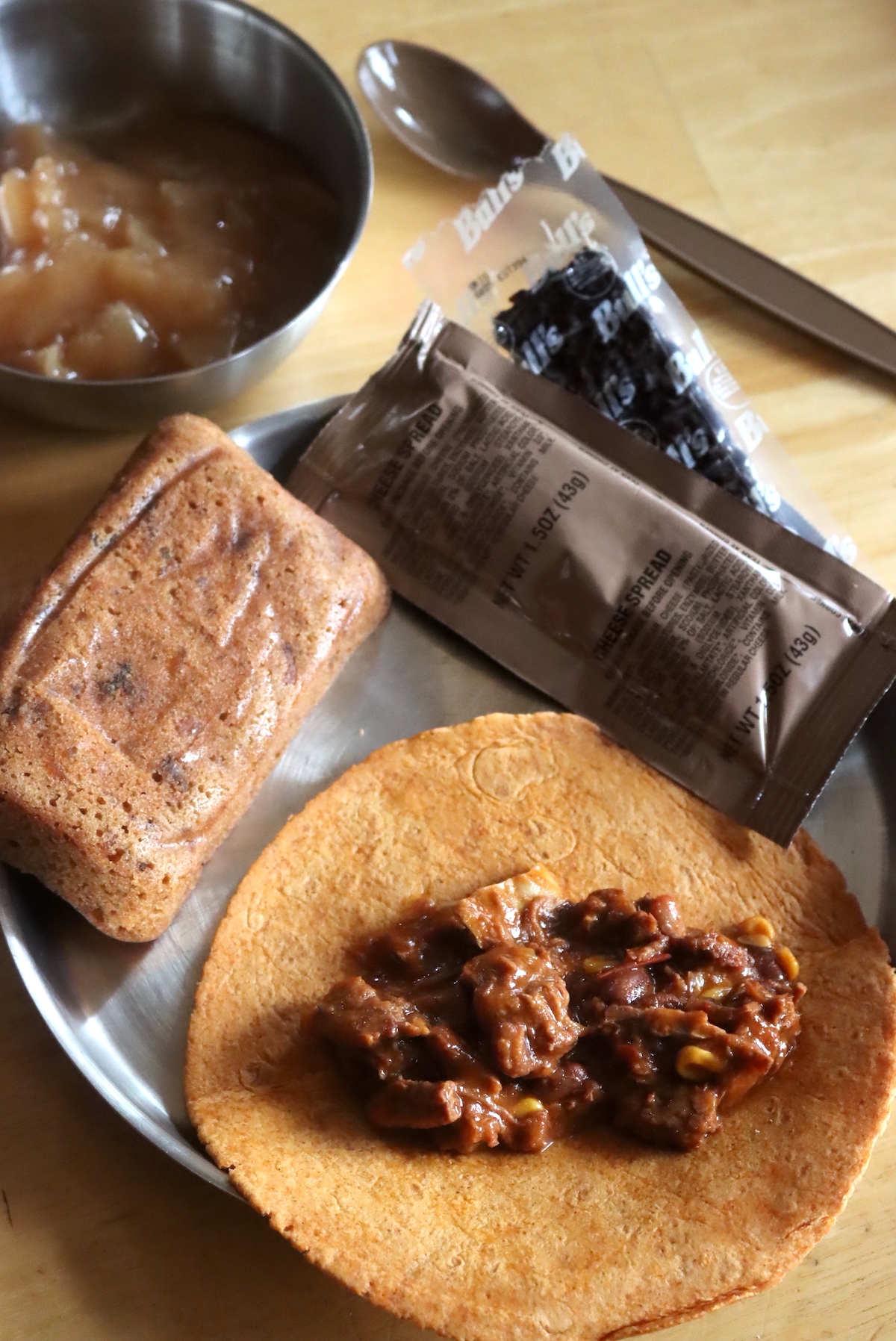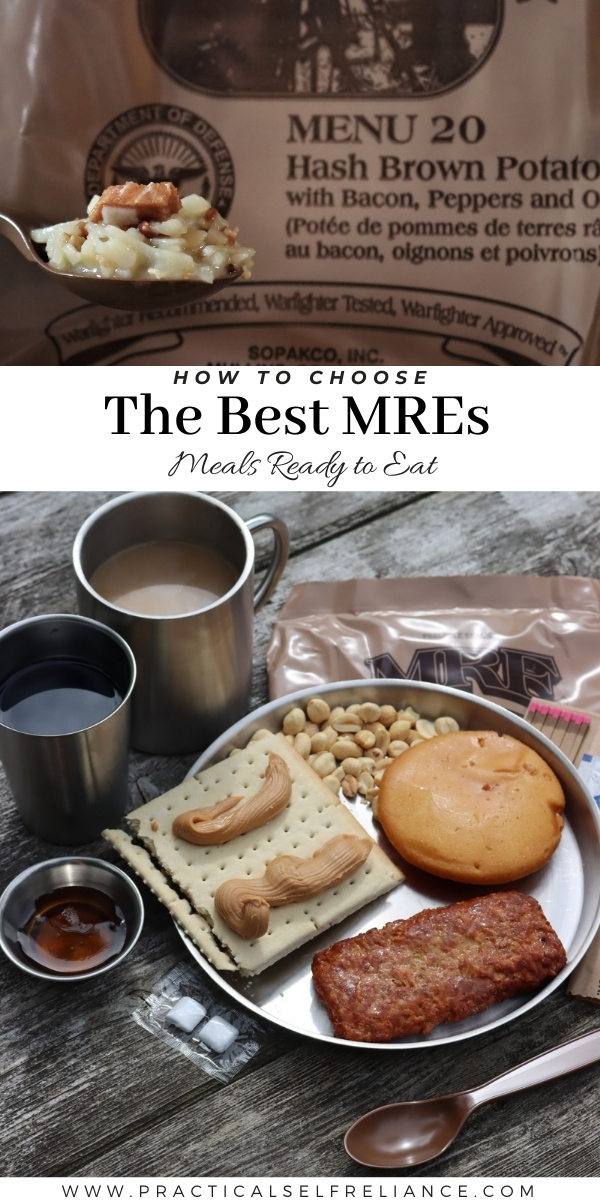Affiliate disclosure: This post may contain affiliate links. Please see our Privacy Policy.
MREs (or Meals Ready to Eat) are perfect for camping or as emergency meals. Some types are better than others, and I’ll take you through the best MRE meals available.

The first time I tried an MRE was nearly 20 years ago, and I’ve eaten many since.
I was 16 years old and at West Point Military Academy for a week-long recruiting trip. At the time, they had an invitation-only program that brought rising high school seniors to campus for a week each summer to live the life of a cadet, hoping to pick up new recruits.
All the food was impeccable that week; it was a recruiting trip after all, but the taste of the MREs sticks with me to this day.
I was completely blown away by how easy it was to pop open the packet right there in the field and have a delicious hot meal within minutes.
When they say “warfighter tested” on the front of the package, they mean that this food is tasty enough to satisfy and motivate someone that might have to charge a machine gun nest later that day.
I was just a kid, used to eating well, and not out of a pouch…but it was still one of the best meals I had that trip.
The thing is, even though MREs are surprisingly good, they’re not the best emergency food for civilians. There are times when the benefits outweigh the downsides, and I’ll walk you through the pros and cons of using MREs off the battlefield.
If you still think MRE’s are the right choice, at the end, I’ll take you through all the options and give you a rundown of the very best MRE meals.
(And yes, I’ve tried every single one, so you don’t have to…)
Where to Buy MREs
It can be difficult to source MREs, regardless of the type. Even if you find a story that carries them, they’re almost always out of stock within hours (or minutes) of an emergency. Knowing out-of-the-way sources can be incredibly helpful.
For those of you that already know what you want, and you’re just looking for a way to get your hands on them, here are a few options:
- Emergency Essentials and My Patriot Supply carry Civilian MREs from MRE Star Brand, and they are some of the most economical choices for civilian MREs.
- Optics Planet has a number of Civilian MRE options like Sopakco Brand, Major Outdoors, and XMRE, as well as both types of Military Grade MRE Case Packs (A&B), but they’re often out of stock, unfortunately. If you do find them in stock, they’re one of the best options.
- The Ready Store sells both Military Grade and Civilian MREs, and they’re one of the few places you can purchase individual meals (rather than case packs). They’ll also sell you just the flameless heaters, which are hard to find in other places.
As a last resort, Amazon sometimes has MRE resellers that carry both Civilian Style MREs and Military Grade MREs. The quality (and outdates) will depend on how reputable the supplier is, and that can be hit or miss with Amazon.
There are also lots of reviews claiming that the case was opened, and the supplier switched the contents. Instead of having the normal mix, it’ll only contain the least desirable meals so they can sell the more popular options individually. Read reviews carefully!
We’ve had good luck with this supplier on Amazon, and they’re one of the few places where you can actually buy military-grade MREs dependably.
(If you’re new to MREs and emergency food in general, read on, and I’ll take you through all the various types.)

What is an MRE?
The term “MRE” stands for “Meals Ready to Eat.” As the name implies, each pouch contains a shelf-stable, self-contained meal that’s basically ready to eat as is.
Open a package, and you’ll find fully cooked food that’s been sealed for long-term storage, as well as a heat pack, cutlery, napkins, and anything else you’d need at mealtime.
Everything can be heated or prepared right in the pouch, meaning there are no dishes.
Unlike freeze-dried emergency food, which requires quite a bit of filtered water to rehydrate, MRE meals are designed to be prepared without access to outside water sources.
Warming the meal requires just 30 ml of water (about 2 tablespoons), and that water doesn’t even have to be potable since it’s not in contact with the food. It’s added to the heat pack to create a chemical reaction that quickly warms the meal in less than 10 minutes.
It’s known as a flameless heater, and though it’s convenient, even that is optional. You can just eat the meal cold out of the package without any prep at all.
They are more or less self-contained rations that can be torn open, warmed, and eaten with nothing else on hand.
Types of MRE
There are two main types of MREs: Military and Civilian.
By far, the best are the military options, but they’re really quite hard to obtain. They contain everything a special forces unit deployed to the harshest environments on earth would need for survival…for days, weeks, or months at a time.
Civilian MREs are similar, and the “entree” meal is nearly identical. The main difference is they’re lower calorie and contain fewer extras like matches, toilet paper, etc.
Civilian MREs
As a general rule, civilians aren’t burning nearly as many calories as active service members. In general, Civilian Grade MREs are lower in protein and higher in comfort foods since they’re usually deployed to emergency or disaster relief operations.
While Military MREs are made for the specific high-calorie needs of active service members, the civilian equivalents have to please everyone, from toddlers to the elderly. Anyone that could potentially live in the path of a hurricane or other natural disaster.
The food is specifically designed to please a wide audience, and it’s all comfort food-style meals.
That said, these types of MREs are still “meals ready to eat” with heat packs, cutlery, and a balanced meal. Most importantly, the main “entree” is almost exactly the same as the Military Grade MREs, though there are fewer options for civilians.
There are 24 different Military Grade MRE meals available, and the selection changes slightly each year. For civilians, there are only half a dozen meal options, and most of them are pasta based.
Civilian MREs are meant to feed people in the aftermath of catastrophic events, like hurricanes or earthquakes, and they’re stored in mass by FEMA and the US government for just such an emergency. They’re not meant as a long-term food source, but rather as a stopgap to feed people for a few days until longer-term relief (or evacuation) is possible.
The food may not look pretty, but you’ll be pretty happy to have hot pasta and a pop tart in the aftermath of a real emergency (hurricanes, wildfires, etc).

Military Grade MRE
While Civilian Grade MREs are used for emergencies, Military Grade MREs are actually used on a daily basis by the armed forces. There are four times as many different meal choices, and they each contain about double the number of calories as the civilian options (plus a lot more protein).
It’s hard to motivate soldiers to risk their lives for sub-optimal rations, and these are really quite exceptional. The “meal” itself is very similar to the civilian option, though with more protein and actual meat, but the “extras” ensure that our armed forces have everything they need to operate in some of the harshest environments on the earth.
Expect to find things like coffee, flavored drinks, toilet paper, mints, and other “extras” that improve the quality of life for active service members.
A MRE meal out of a package may not look pretty on a plate, but it’s incredibly filling and satisfying.

How Long Does an MRE Last?
Believe it or not, MREs aren’t meant for long-term storage. At least, not compared to other types of emergency food storage, like freeze-dried food which lasts over 25 years.
When stored at room temperature, MREs are rated to last 3 to 4 years.
The shelf life drops off dramatically when they’re stored at higher temperatures, like in hot arid environments. Stored at over 100 degrees F they’re rated for less than 6 months, which is a problem in long desert-based warfare. Shelf life increases when they’re kept cool, and they’re rated for five years when kept at 50 degrees F.
Still, 3 to 4 years at room temperature is quite a long time.
In the military, they don’t actually have “out dates” on their MREs; they have “inspection dates” instead. When it gets to the inspection date, the crate is inspected and usually certified for another few years. In truth, MREs can potentially last much longer than their rated lifespan if stored in a relatively cool location (basement, back closet, etc.).
What’s Included in an MRE?
The exact contents of an MRE will vary from pouch to pouch, and that’s intentional. If you’re eating these on a regular basis they’re designed to give you some variation.
Civilian MREs
Civilian MREs have much less variation, as they’re only designed for very short-term emergency use. Expect to find:
- 1 Protein Bar or Pop Tart (usually pop tarts in the civilian version)
- 1 Extra Treat (candy)

Military Grade MREs
Military MREs are almost twice as big, with many more calories and sides. The meal itself is higher in protein, and there are two dozen options (only a few of which are pasta). Expect to find:
- 1 Pack of Crackers, Bread, Pancakes, or Tortillas
- 1 Beverage Powders (Hot Chocolate, Grape Drink, Protein Powder)
Everything about the Military Grade MRE is of higher quality, and even the spoon is more durable than your average plastic spoon.

How to Cook an MRE
When you’re preparing an MRE, you’re not actually “cooking” it, as the food is already fully cooked. All you’re doing is heating the food so it’s more enjoyable. A warm meal is much more satisfying than a cold one, but it can be eaten cold in a pinch.
To use the flameless heater in an MRE package, start by opening the outer pack. Inside you’ll find individual pouches of food, crackers, and more. Look for the entree, which will be in a vacuum seal pouch and have a label that matches the meal name from the main package.
You’ll also need to locate the flameless heater, which will be a long plastic pouch with instructions written on the outside. Don’t reach in and take out the heat pack; leave that inside and read the instructions on the heater pouch.

While it’s always possible that the instructions may vary slightly depending on how and when the MRE was made, in general, they should be similar to this:
- Locate the MRE entree pouch and cardboard sleeve.
- Place the MRE meal pouch into the bag with the heater.
- While holding the MRE and heater slightly above the fill lines on the pouch, pour water into the top of the bag until it reaches the fill line. (Around 30 ml or two tablespoons)
- Slide the meal and heat pack down into the water.
- Fold the top of the heat pack over, and insert the MRE heat pack into the cardboard sleeve (for insulation). Be sure the heat pack is under the meal, as the heat rises.
- Prop the pack up on a rock or your boot, to keep water from leaking. The open end should be up.
- Wait about 10 minutes, then remove the meal from the heat pack and eat.
Be sure to dispose of the heat pack in a safe space, as it will continue reacting, potentially for several hours. Don’t just toss it in the trash at this point, as there’s a small fire risk.
While your entree is propped up and is heating in the pouch, you can eat all the rest of the food. Usually, it’ll be snack-type items (nuts, dried fruit), some type of bread or crackers, or some type of jerky. Often it’ll include treats and drink mixes too.

For a Civilian MRE, the preparation is exactly the same. The meal itself will likely be a pasta-based dish, and it’ll include TVP instead of actual meat (which is only in the Military MREs).
While the whole meal is a bit smaller, with less protein and calories, the actual entree preparation and heat pack follow the same instructions.
Add a bit of water to the pouch, put the meal in, fold it over, insert into the cardboard sleeve, and prop it up on something for about 10 minutes.

Pro’s and Cons of MRE Meals
MREs are incredibly convenient in an emergency, but they may not be the best option for emergency food storage, depending on your situation.
Pros
- The flameless heater warms food without other cooking appliances
- No added water needed
- Portable, self-contained pouches
- Stores 3 to 4 years at room temperature
Cons
- Heavy and bulky compared to freeze-dried options (water is in the food, so more weight)
- Expensive! They cost considerably more than other food storage options.
- The flameless heater can be a disposal hazard
- Limited meal choices (especially in civilian options)
MREs are a great option where water, especially potable water, is limited. That could be in arid regions, but also somewhere water has been contaminated by weather events (hurricanes, etc).
Though they’re relatively heavy compared to freeze-dried options, they’re easy to transport should you have to evacuate. Since they can be prepared without cooking equipment, they’re ideal for car preparedness or eating on the go.
While they may be a good short-term, portable option, they’re just not the best for long-term “shelter in place” type scenarios. If you have very limited water in those situations, you’re in trouble anyway. And if you don’t have cooking or heating options, odds are you’ll be in trouble after a few days anyway.
I think they’re an excellent option for short-term use, don’t plan on packing in for weeks at a time with MREs. In those situations, freeze-dried emergency food kits are a better option. Many just require pouring boiling water over the food to prepare, and they’re much more economical (and long-lasting) than MRE meals.
Best MRE Meals
Often MRE meals can be hard to find, so in some senses, the best MRE meal is the one available. If you have a choice, the Military Grade options are definitely the best.
They’re a bit more expensive, often as much as twice the price depending on the supplier (usually, they’re only around 1.5 times as expensive). That said, they also provide about twice as much food per meal, and far more nutrition.
Civilian MREs have a lot of sugar and carbs, but they’re light on protein. They’re meant to provide short-term comfort and relief, which in many emergency scenarios is more than enough.
MRE Meal Types
The actual meals to choose from will depend on your personal tastes, and some people are going to enjoy one type of meal better than others.
Military MREs come in two case packs, each with 12 different meals. They change slightly yearly, but many of the most popular meals remain the same.
Case Pack A (2021 inspection date) includes:
- Menu 1: Chili with Beans
- Menu 2: Shredded Barbecue Beef
- Menu 3: Chicken with Noodles & Vegetables
- Menu 4: Spaghetti with Beef and Sauce
- Menu 5: Chicken
- Menu 6: Beef Taco
- Menu 7: Brisket Entree
- Menu 8: Meatballs in Marinara Sauce
- Menu 9: Beef Stew
- Menu 10: Chili and Macaroni
- Menu 11: Vegetarian Crumbles with Taco Sauce
- Menu 12: Vegetarian Pasta with Tomato Sauce
Case Pack B (2021 inspection date) includes:
- Menu 13: Vegetarian Cheese Tortellini in Sauce
- Menu 14: Vegetarian Mushroom Fettuccine
- Menu 15: Maple Pork Sausage Patty
- Menu 16: Rib-Shaped BBQ Pork Patty
- Menu 17: Mexican Style Chicken Stew
- Menu 18: Beef Ravioli in Meat Sauce
- Menu 19: Jalapeno Pepper Jack Beef Patty
- Menu 20: Hash Brown Potatoes with Bacon
- Menu 21: Lemon Pepper Tuna
- Menu 22: Asian Style Beef Strips with Vegetables
- Menu 23: Chicken Pesto Pasta
- Menu 24: Southwest Beef and Black Beans
My personal favorites are Hash Brown Potatoes with Bacon, Southwest Beef and Black Beans (which comes with tortillas), and Chicken Pesto Pasta.

For civilian MRE options, just about every one includes an entree with pasta, tomato sauce, and TVP (textured vegetable protein). They may go by different names (ie. Lasagna, tortellini, macaroni, etc) but they’re all very similar in flavor and texture.
It’s basically a big box of ready-to-heat and-eat pasta with sauce, plus flameless heaters and comfort food snacks (pop tarts, etc.).
Civilian MREs come in a number of different brands. Sopakco and MRE Star are the best-known, and best-tasting.
Beyond MREs for Emergency Food
There are many other emergency food options if you’re willing to plan for even a small amount of cooking, literally just being able to boil water in an emergency.
Something like a jet boil camping stove which uses butane canisters, is what we use when camping. It’ll boil water in under 3 minutes, and a single 16 oz fuel canister can run for well over 2 hours.
A small rocket stove that efficiently burns twigs and bark like this one from solo stove will also do the trick, and fuel is easier to come by in an ongoing way.
Biolite makes a camp stove that converts heat energy to electricity to charge devices while it burns, so it’s working double duty. (Though a portable power bank is a much more dependable way to generate and store electricity in an emergency, the biolite power will just make enough to charge your phone or head lamp.)
However you manage it, being able to boil water will allow you a lot more options. Beyond that, it’ll cost considerably less as MREs are by far the most expensive option for emergency food.
All of the best emergency suppliers make long-term storage (25+ year shelf life) freeze-dried food kits that are less expensive and better tasting than MREs. I’ve sampled them all, and done detailed reviews of everyone.
If you want the quick version:
- My Patriot Supply has the best budget kits on the market, and if you don’t have a lot to spend they’ll get you through better than anyone else. (Read my complete My Patriot Supply Review)
- Valley Food Storage has the best quality kits with plenty of variety, and a number of pre-made kits that are perfect for just in case. (Read my complete Valley Food Storage Review)
- Nutrient Survival had the highest nutrient density and best-tasting food, but their options are a bit more limited since they’re a new company. (Read my complete Nutrient Survival Review)

Preparedness Resources
Looking for more Preparedness Resources?
- Pedal Powered Washing Machine for Off-Grid Laundry
- Survival Gardening: Our Real Life Dry Run
- Choosing a Survival Seed Bank
- Can You Survive a Nuclear Winter?
- 4Patriots Survival Food Review (Read Before You Buy!)















I am looking for Long term Military MRE’S with High Protein and also Water pouches for Emergencys and also Day to day basis food supplies.
If you search for “MRE” on the blog you will find several posts about survival or emergency food options.
Thanks for this article and its update. Very informative with what seems to be very thorough approach.
Thanks for the information. Ive been trying weed through different sites. You gave me the info. I needed to make best choices.
I’ve been purchasing MyPatriotSupply meals for quite a while. They have quality and taste that isn’t overpowered with a chemical background. They had a shipping issue with boxes coming open during shipping but have corrected the problem.
I’m glad to see your high rating of them. I have other brands stashed that I’ve not tasted but have trusted to be acceptable.
I’ve signed up for your site for updates and look forward to your knowledge for prepping.
Thanks so much for sharing that and We’re so glad that you’re enjoying the posts.
This is a great article showing the best MRE meals! I love how you gave extra information like how long MREs last, what you can expect in an MRE, and even the different MRE meals that you can get. How often do you usually get and consume MRE meals?
I’m glad you enjoyed the article. MREs are not something that we really consume on a regular basis.